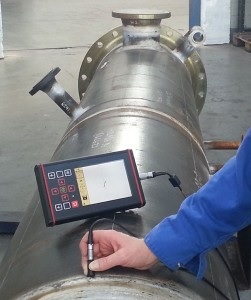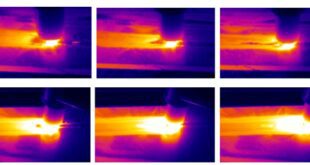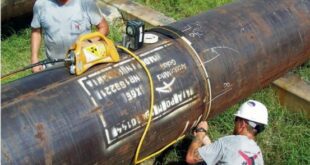Eddy Current Testing (ECT) – NDT Inspection
Introduction
Definition of Eddy Current Testing
Eddy Current Testing (ECT) is a non-destructive testing (NDT) technique that is used to detect surface and near-surface defects in conductive materials. ECT works on the principle of electromagnetic induction and is capable of detecting defects such as cracks, corrosion, and material thickness variations. The technique is widely used in a variety of industries, including aerospace, automotive, power generation, and nuclear, to ensure the safety and reliability of critical components.
Importance of ECT in Non-Destructive Testing (NDT)
ECT is a vital technique in the field of non-destructive testing (NDT) due to its ability to quickly and accurately detect defects without damaging the material being tested. This makes it a cost-effective and safe method of testing, particularly in industries where safety is of utmost importance, such as aerospace and nuclear. ECT can detect defects that are not visible to the naked eye and can identify issues in the early stages, helping to prevent catastrophic failures and accidents.
ECT is also a versatile method of testing and can be used on a range of materials, including metals, alloys, and non-ferrous materials. It can be used to test a variety of components, including pipes, pressure vessels, and structural components. The ability of ECT to detect defects in materials quickly and accurately can reduce downtime and maintenance costs for industrial processes, making it a valuable tool for quality control and inspection.

Basic Principles of Eddy Current Testing
Electromagnetic Induction
Electromagnetic induction is the fundamental principle behind eddy current testing. When an alternating current (AC) is passed through a coil of wire, a magnetic field is created around the wire. This magnetic field is also known as the primary magnetic field. When the primary magnetic field is brought close to a conductive material, such as a metal plate, it induces eddy currents within the material. These eddy currents generate a secondary magnetic field that opposes the primary magnetic field. The interaction between the primary and secondary magnetic fields results in a change in the electrical impedance of the coil, which can be measured and used to detect defects in the material.
Eddy Current Generation
Eddy current generation occurs when a conductive material is exposed to a changing magnetic field, such as the one generated by the primary magnetic field in eddy current testing. As the magnetic field changes, it induces electrical currents within the material, known as eddy currents. The magnitude of the eddy currents depends on the magnetic field strength, the frequency of the AC, and the electrical conductivity of the material. Eddy currents are concentrated near the surface of the material and decrease in magnitude as the distance from the surface increases.
Eddy Current Response
Eddy current response is the measurement of the electrical properties of the material being tested in response to the eddy currents generated by the primary magnetic field. The response is measured using a probe, which consists of a coil of wire connected to an electronic circuit. As the probe is moved over the surface of the material, changes in the electrical properties of the material induce changes in the electrical impedance of the coil. These changes can be measured and analyzed to determine the presence and location of defects such as cracks, corrosion, and material thickness variations.
Factors Affecting ECT
Several factors can affect the accuracy and reliability of Eddy current testing. These include:
- Electrical conductivity and magnetic permeability of the material being tested.
- Thickness of the material being tested.
- Shape and size of the probe.
- Frequency and amplitude of the AC signal used to generate eddy currents.
- Surface condition of the material being tested.
- Environmental factors, such as temperature and humidity.
- Operator skill and experience.
Applications of Eddy Current Testing
Aerospace Industry
The aerospace industry is one of the most significant users of Eddy Current Testing due to the critical nature of the components used in aircraft. ECT is used to inspect the surface and near-surface of aircraft components such as engine parts, wing structures, and landing gear for cracks, corrosion, and other defects. The technique is also used to detect defects in fasteners, bolts, and other small components that are difficult to inspect using other NDT techniques. ECT is a valuable tool in the aerospace industry as it can detect defects at an early stage, preventing catastrophic failures and ensuring the safety of passengers and crew.
Automotive Industry
The automotive industry also relies on Eddy Current Testing to ensure the safety and reliability of critical components. ECT is used to inspect automotive components such as engine blocks, crankshafts, and gears for cracks, corrosion, and other defects. The technique is also used to test the welds and bonding of components, ensuring the strength and integrity of the vehicle. ECT is a fast and efficient method of testing that can identify defects in a range of automotive components, improving the overall quality of vehicles and reducing the risk of accidents.
Power Generation Industry
The power generation industry uses Eddy Current Testing to inspect critical components such as heat exchangers, boilers, and turbines for defects. ECT is a valuable tool in this industry as it can detect defects in non-ferrous materials such as copper and aluminum that are commonly used in power generation equipment. ECT is also used to inspect tubes and pipes for defects such as corrosion and erosion. The technique is a non-destructive method of testing, allowing components to be inspected without causing damage, reducing maintenance costs and downtime.
Nuclear Industry
The nuclear industry is another significant user of Eddy Current Testing due to the critical nature of the components used in nuclear reactors. ECT is used to inspect reactor components such as fuel rods, heat exchangers, and steam generators for defects such as cracks and corrosion. The technique is a valuable tool in the nuclear industry as it can detect defects at an early stage, preventing catastrophic failures and ensuring the safety of workers and the public. ECT is also used to test the integrity of welds and other joining techniques used in nuclear components, ensuring the strength and reliability of the equipment.
Advantages and Limitations of Eddy Current Testing
Advantages
- Non-Destructive: Eddy Current Testing is a non-destructive method of testing, which means it does not cause any damage to the material being tested. This makes it ideal for testing critical components that cannot be damaged or destroyed during the testing process.
- Versatile: ECT can be used to inspect a wide range of materials, including metals, alloys, and non-ferrous materials. The technique is also sensitive to changes in material properties such as conductivity and permeability, allowing it to detect defects in a range of materials.
- Fast and Efficient: ECT can be performed quickly and efficiently, making it a valuable tool in industries where time is of the essence. The technique can also be automated, allowing for high-speed inspection of large quantities of components.
- Cost-Effective: ECT is a cost-effective method of testing as it does not require any special preparation of the material being tested. The technique is also non-destructive, reducing the need for costly repairs or replacements.
- High Sensitivity: ECT is highly sensitive and can detect small defects in the surface and near-surface of materials, including cracks, corrosion, and other types of damage. This allows for early detection of defects, preventing catastrophic failures and reducing the risk of accidents.
Limitations
- Limited Depth of Penetration: The depth of penetration of ECT is limited, typically to a few millimeters. This means that defects deep within the material may not be detected using ECT.
- Sensitivity to Surface Conditions: ECT is highly sensitive to surface conditions such as roughness and contamination. The technique may produce false positives if the surface is not prepared properly, leading to unnecessary repairs or replacements.
- Limited Effectiveness on Ferromagnetic Materials: ECT is not effective on ferromagnetic materials such as steel and iron, as the magnetic properties of these materials interfere with the generation and detection of eddy currents.
- Operator Dependent: ECT requires skilled operators to perform the inspection correctly. Improper use of the technique may lead to inaccurate results and missed defects.
- Limited Inspection Area: ECT is limited to the area that can be inspected by the probe. This means that large or complex components may require multiple inspections to ensure complete coverage.
Eddy Current Testing Equipment and Techniques
Equipment Used in ECT
- ECT Instrument: The ECT instrument generates and detects eddy currents in the material being tested. It typically consists of a signal generator, a receiver, and a display unit.
- Probes: Probes are used to generate and detect eddy currents in the material being tested. They are available in a variety of shapes and sizes to suit different applications.
- Coupling Medium: A coupling medium is used to transfer the eddy currents from the probe to the material being tested. The medium can be a liquid or a solid depending on the application.
- Calibration Standards: Calibration standards are used to ensure that the ECT instrument is functioning correctly and that the results obtained are accurate.
Techniques Used in ECT
- Absolute Technique: In the absolute technique, the ECT instrument is calibrated using a standard reference material of the same size and shape as the material being tested. The reference material contains known defects that are used to calibrate the instrument.
- Differential Technique: In the differential technique, the ECT instrument is calibrated using a reference material that does not contain any defects. The instrument is then used to test the material being inspected, and any differences between the two readings are indicative of the presence of defects.
- Bridge Technique: In the bridge technique, the ECT instrument is calibrated using a bridge circuit. The circuit is balanced with the reference material, and any deviations in the circuit indicate the presence of defects.
- Pulsed ECT: Pulsed ECT is used to detect deeper defects in the material being tested. The technique involves using a high-frequency pulse to generate eddy currents, which are then detected by the probe.
ECT Probes
- Surface Probes: Surface probes are used to detect defects on the surface of the material being tested. They are available in a variety of shapes and sizes to suit different applications.
- Encircling Probes: Encircling probes are used to detect defects in the entire circumference of a tube or pipe. They are designed to fit around the outside of the tube or pipe and are available in a variety of sizes.
- Internal Probes: Internal probes are used to detect defects inside pipes and other hollow components. They are typically inserted into the component being tested and are available in a variety of sizes and shapes.
- Array Probes: Array probes are used to inspect large areas of the material being tested quickly and efficiently. They consist of multiple probes arranged in a specific pattern to provide complete coverage of the inspection area.
Eddy Current Testing Procedures
Preparation for ECT
- Surface Preparation: The surface of the material being tested must be cleaned and free from any contaminants that may interfere with the eddy current inspection process.
- Coupling Medium: The appropriate coupling medium should be selected based on the material being tested and the probe being used. The coupling medium must be applied evenly to ensure good contact between the probe and the material being tested.
- Calibration Standards: Calibration standards should be selected and prepared according to the requirements of the specific inspection. The calibration process should be conducted in accordance with the manufacturer’s recommendations.
Conducting ECT
- Probe Selection: The appropriate probe should be selected based on the size, shape, and material of the component being tested. The probe should be positioned correctly to ensure that it is generating eddy currents in the desired area.
- Instrument Settings: The instrument settings should be adjusted based on the specific requirements of the inspection, such as the frequency, gain, and phase angle.
- Scanning Technique: The probe should be scanned over the surface of the material being tested in a systematic and controlled manner to ensure complete coverage. The scanning speed and direction should be controlled to ensure that all areas are inspected thoroughly.
- Defect Detection: The instrument display should be monitored for any indications of defects, such as changes in amplitude or phase angle. Any defects detected should be marked for further evaluation or repair.
Interpreting ECT Results
- Evaluation Criteria: The evaluation criteria used to determine the significance of any detected defects should be established before the inspection. The criteria may be based on industry standards, regulatory requirements, or customer specifications.
- Data Analysis: The data obtained during the inspection should be analyzed to determine the nature, size, and location of any detected defects. This analysis may be conducted manually or using automated analysis software.
- Reporting: A report should be prepared that includes all relevant information obtained during the inspection, including the inspection procedure, inspection results, and evaluation criteria used. The report should be clear and concise and include recommendations for any necessary repair or further evaluation.
FAQs
What is the principle of ECT NDT?
ECT NDT uses the principle of electromagnetic induction to detect flaws and discontinuities in conductive materials. An alternating current is passed through a coil, creating a magnetic field that induces eddy currents in the material being tested. These eddy currents generate their own magnetic field, which interacts with the original magnetic field, causing a change in the electrical impedance of the coil. This change is then measured and analyzed to detect any defects in the material.
What is the difference between ECT and UT?
ECT and UT (Ultrasonic Testing) are both non-destructive testing methods, but they use different principles to detect flaws in materials. ECT uses electromagnetic induction, while UT uses high-frequency sound waves to penetrate materials and detect internal defects.
What is the difference between ECT and MPI?
ECT uses electromagnetic induction to generate eddy currents while Magnetic Particle Inspection (MPI) uses magnetic fields and magnetic particles to detect defects.
What is eddy current test used for measuring?
Eddy current testing is used to measure the electrical conductivity, thickness, and integrity of conductive materials. It is commonly used to detect surface cracks, corrosion, and other defects in components such as pipes, tubes, and aircraft parts.
What is the temperature of Eddy current testing?
The temperature of eddy current testing depends on the material being tested and the environment in which the testing is being conducted. In general, ECT can be performed at a wide range of temperatures, from room temperature to high temperatures of up to 1000°C or more, depending on the type of probe and equipment being used.
What is the function of ECT?
The function of ECT is to detect defects and discontinuities in conductive materials without causing damage to the material being tested. ECT can detect surface cracks, corrosion, and other defects in components such as pipes, tubes, and aircraft parts, ensuring their safety and reliability.
What is the voltage of ECT?
The voltage of ECT can vary depending on the type of material being tested and the equipment being used. Typical voltage ranges for ECT are between 1V and 100V.
What are the two types of ECT?
The two types of ECT are absolute and comparative ECT. Absolute ECT is used to measure the electrical conductivity and thickness of materials, while comparative ECT is used to detect defects and discontinuities in conductive materials.
Why is it called eddy current?
ECT is called eddy current because it uses eddy currents, which are circular electric currents induced in conductive materials by a changing magnetic field. The term “eddy” refers to the circular motion of the current, similar to the circular motion of water in an eddy.
Why do we use eddy current?
We use eddy current to detect flaws and discontinuities in conductive materials, without causing damage to the material being tested. ECT is a non-destructive testing method that can detect surface cracks, corrosion, and other defects in components such as pipes, tubes, and aircraft parts, ensuring their safety and reliability.
What is Eddy current strength?
Eddy current strength refers to the magnitude of the eddy currents induced in a material during ECT. The strength of the eddy currents depends on the properties of the material being tested, as well as the frequency and amplitude of the applied magnetic field.
Conclusion
Summary of ECT
Eddy Current Testing (ECT) is a non-destructive testing (NDT) technique that uses electromagnetic induction to detect flaws and discontinuities in conductive materials. ECT is widely used in various industries, including aerospace, automotive, power generation, and nuclear, to inspect components for defects that may affect their performance or safety. The basic principles of ECT include electromagnetic induction, eddy current generation, eddy current response, and factors affecting ECT.
Importance of ECT in NDT
ECT is an important NDT technique because it can detect flaws and discontinuities that may not be visible to the naked eye, allowing for early detection of potential issues and reducing the risk of catastrophic failures. ECT is non-destructive, meaning it does not damage the material being tested, making it a cost-effective and reliable method of testing. ECT is also highly sensitive and can detect very small defects, making it useful for inspecting complex and critical components.
Future Developments in ECT Technology
As technology advances, the field of ECT is also evolving. New developments in ECT technology include improvements in probe design, such as the use of arrays of smaller probes, and advances in signal processing and data analysis. These developments are leading to more accurate and efficient inspections, allowing for greater reliability and safety in various industries.
 Welding of Welders All about Welding and Welders
Welding of Welders All about Welding and Welders



